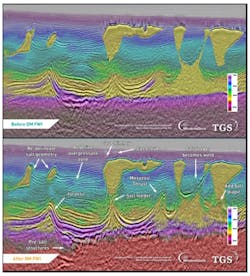Offshore staff
HOUSTON – TGS has introduced Dynamic Matching Full Wave Inversion (DM FWI) technology.
The new imaging approach uses seismic reflection and refraction information to automatically update the velocity model, enabling high-quality images in geologically complicated areas.
DM FWI delivers a step-change in velocity model quality, facilitating clearer and geologically consistent depth images, the company said.
The TGS inversion-based algorithm can reduce imaging cycle time and interpretation ambiguity. It works in tandem with new ocean bottom node survey designs and is also applicable to modern towed streamer survey designs. The new approach can be applied in a wide range of geologic settings with particular relevancy in geologically complex areas like salt basins and where there are shallow gas anomalies - enabling faster and more evident geological interpretations.
Jan Schoolmeesters, executive vice president of Operations at TGS, said: “We appreciate the significant pressure that E&Ps are under to maximize efficiency, reduce cycle times and cut costs and therefore have a need for reduced subsurface uncertainty to help them de-risk prospects faster. With DM FWI, we are delighted to help them overcome their challenges with timely and efficient imaging technologies and processing workflows.”
Amendment Phase I, a joint venture program with WesternGeco, is the first project to use the new technology. The application to this sparse node dataset with ultralong offsets in the US Gulf of Mexico demonstrates the capability to resolve large velocity errors and provide uplift on the sub-salt image.
06/08/2020



